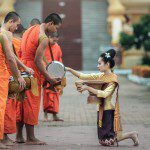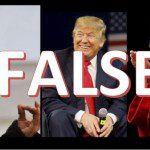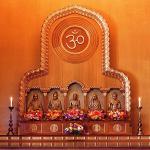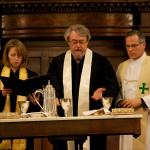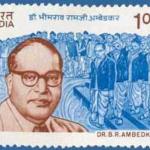Growing up Catholic in the US, I have a certain fondness for Christmas songs – especially loving the voices of Bing Crosby, Dean Martin, Nat King Cole, Ella Fitzgerald, Elvis Presley, and others of a certain bygone era of American music. So when I stumbled across this beautiful Buddhist Christmas song (or a Buddhist song set to a modern Christmas tune), I was hooked. This week I got in touch with the song’s creator, Ryan Hunt, for an interview. Please read, enjoy the music below, print/share the lyrics and sing them with friends and family and support Ryan in his efforts to turn this into a full album:
JW: This song, “The First Nidana” is what drew me to you. It is gorgeous. And as a lapsed Catholic / Buddhist / Unitarian Universalist it managed to pull together so many of my life’s traditions and beliefs in one really beautifully composed package. Can you tell me about this song in particular? How did you come about creating it and finding Lydia Salnikova, the vocalist, to record it?
RH: Actually the chorus came to me first. I was just humming the tune to the First Noel and suddenly the words Aware, aware, aware, aware popped into my head while humming. From there I started thinking a bit more deeply about the words in The First Noel, and since it is about the divine birth of Jesus, I thought it might be interesting to see how the concepts of Dependent Origination would fit to the melody. Dependent Origination delineates the causal links leading to birth of our ego in each and every moment. Since the first causal link or Nidana is avija or ignorance I thought it particularly fitting to call the title The First Nidana. The teaching on Dependent Origination is one of my favorite teachings as was one of the first things I learned when I spent a year on personal retreat in Wat Suan Mokkh in the mid-Nineties.
As for selecting Lydia, I could hear the song being sung in my head before very clearly, and I listened to about a hundred different vocalists to find her. The songs I heard of hers didn’t sound anything like what I was imagining but there was a quality in her voice that I knew would match exactly what I was looking for if she could pull it off. When I got her draft version of the song back from her, I was so over joyed I actually broke down sobbing. It was perfect and exactly what I had wanted. I am really happy with her sound, and am looking forward to having her sing several more of the songs once I am able to get enough funds together to make more.
JW: I saw that your background is as an American raised in Christianity but you are now a Buddhist living in Hong Kong. Tell me more about the bridges this work and your life represents.
RH: This is a great question, and really at the heart of these songs. When I was younger I grew dissatisfied with my own religious tradition and felt like I needed to abandon it, but when I was living at Suan Mokkh I realized 1) that I didn’t need to abandon it if I could understand it in the context of Dharma, and 2) even if I tried I would not really be successful until the karmic connection was exhausted. The longer and deeper I practice Dharma the more I find myself delving into the motivational circumstances of my young adult life and early childhood and how the psychology of that time in my life impacts me today.
In 2015 after coming back from pilgrimage in Tibet, I felt a renewing surge of creativity in my life, and songs and poetry just started bubbling up until I started writing them down. While I used to write quite a bit when I was young, in the past ten or so years there developed a lot of stuck energy for me around writing, the method and the contents, but I seem to have reached a place where I am more accepting of the expression of my creativity now and what arises. If people like it great, if they are repulsed by it in many ways also great since in either case it can be fuel for reflection if they want to take it that way. If there is no reaction at all by someone then there is probably just not enough connection to their life experience to be a mirror, and that is OK too.
JW: How did you discover Buddhism for yourself and how would you describe your identity/practice today?
RH: I used to go on vacation as a child and in the hotels there would be a little book called “Teachings of the Buddha” with a sunset orange cover. I really gravitated to this, and read the entire thing. There were not a lot of opportunities other than thru books for me to connect with Buddhism until I went to Suan Mokkh, and when I went there I went without expectations. By then I had been delving into many faith traditions: different sects of Christianity, Baha’i, Islam, Hinduism, Judaism, even the mystical traditions, the occult and Satanism. By the time I was done with my time at Suan Mokkh I knew I had found my path and my practice, and it was really circumstance that kept me from ordaining into the monastic order there.
Later I met my wife who introduced me to Vajrayana, and the connection was strong and immediate. The teachings of the Vajrayana, especially the Nyngma tradition felt natural. When I would hear the teachings it was like I was hearing something I knew from long ago and was being reminded of in a very profound way. Often I still feel that way even today when listening to teachings. As if a wire is getting pulled tight between this moment and one long ago, and the sound is getting carried across time just like running a piece of yarn between two paper cups when we were kids to have a conversation with our friends in the other room.
JW: One of the lyrics of “The First Nidana” that stood out to me was “Identity leads to our demise, accept old age, sickness and dare to be wise.” As a Buddhist, this rings bells right away, but how do you think this strikes non-Buddhist listeners?
RH: It’s impossible for me to know how others might take it. I think as the world becomes more connected people of all faith traditions are seeing the impact clinging to our different identities has in promoting war and violence both externally in the world and internally in our own neurotic personalities. There is a big difference between enjoying and sharing our culture and experiences in life and dogmatically adhering to views as something to stand between us and separate us as humans. So while I don’t know all the ways how non-Buddhists might interpret the lyrics, I would hope they use the familiar melody as an opportunity to connect with and try to understand the perspective shared by a huge segment of earth’s population.
JW: Any plans on live performances?
RH: Not really. I am not a professional musician, and this all started just because it was naturally arising for me and I thought it would be fun to have the songs for my kids. I did the first recording simply because I thought it would be good to share with others, and if enough people connect to the idea would try to record enough for a full album. Right now my plan is to donate any profit from this song and the album if it gets created to Dharma organizations in support monastic and lay practitioners. I have a full time job in technology and am a full time dad and husband, so trying to coordinate any kind of real performance is not currently in the cards.
JW: What else is in the plans for 2017 and beyond? You mention that you have a whole album in the works. How is work going on that and how can people help support your work?
RH: Yeah, I currently have about 17 Christmas Carols and about 10 song to other melodies like folk, pop and even rock and roll. The most direct way to support getting them recorded is to go to the website: http://carolofthedharmabells.
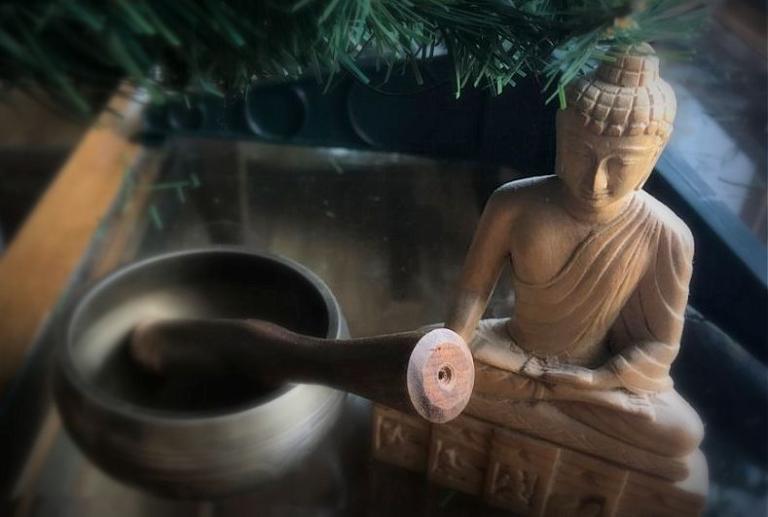
“The First Nidana” is available for download at carolofthedharmabells.com (where you can purchase the song for $1 or donate more), iTunes and CD Baby. You can also pre-order the album Carol of the (Dharma) Bell or sponsor the production of a song here.
The First Nidana
The first nidana is called ignorance
Samsara gives false deliverance
Idappaccayata—this leads to that
Paticcasamuppada—begat
Aware, aware, aware, aware
Being aware is beyond compare
Now ignorance gives rise to compounding cause
Then consciousness rises without a pause
Next consciousness leads to bodymind
Sense faculties are then formed in kind
Aware, aware, aware, aware
Being aware is beyond compare
Sense faculties then cause connection
Leading down the path to sense perception
The next basic cause is craving
This then brings attachments mental raving
Aware, aware, aware, aware
Being aware is beyond compare
Attachment gives rise to gestation
Then comes birth and origination
Birth always leads to the same story
That compounding is illusory
Aware, aware, aware, aware
Being aware is beyond compare
Identity leads to our demise
Accept old age, sickness and death to be wise
This process is our innate condition
Dependent Origination
Aware, aware, aware, aware
Being aware is beyond compare
Awareness that is free of Dukkha’s embrace
Will guide us on the path to nirvana’s grace
Truth can never be found near or far
Yet in our heart is the light of that star
Aware, aware, aware, aware
Being aware is beyond compare
Aware, aware, aware, aware
Being aware is beyond compare
Aware, aware, aware, aware
Being aware is beyond compare
Like this? Support more content like this by becoming an American Buddhist Perspectives Patreon here.

